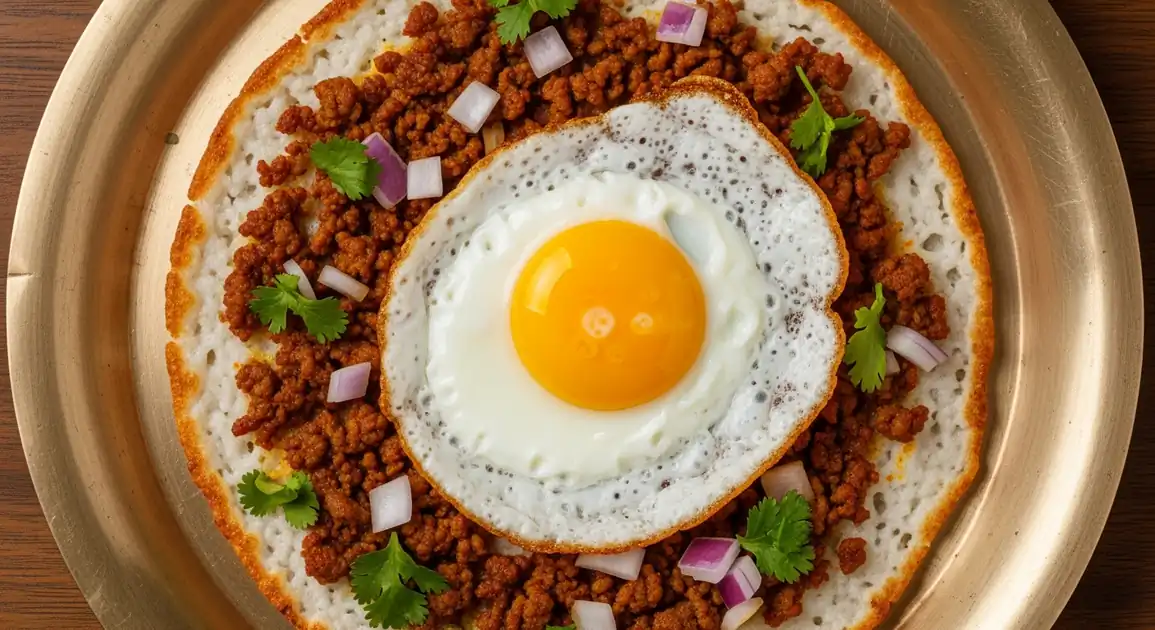Chatamari (Newari Pizza)
चटामरी (Chatāmarī)

Description
Chatamari is a signature dish of the Newari people, predominantly found in the Kathmandu Valley (Kathmandu, Lalitpur, Bhaktapur). However, due to its popularity, it's available in many towns and cities across Nepal, especially in areas with Newari migrants or those catering to tourists. Authenticity is highest in the valley.
Dietary Information
Serving information
Serving style
Served hot, usually on a metal plate (often brass in traditional places). Eaten with hands or sometimes with a fork/spoon. Often served alongside other Newari snacks like Bara (lentil patty) or Aloo Tama (potato and bamboo shoot soup).
Quick facts
Local Khaja Ghars: Typically 11 AM - 7 PM. Tourist Restaurants: Often later, 12 PM - 10 PM.
Safety Tips
What to Look For
-
Made fresh to order on a hot griddle ('tawa')
Ensures the Chatamari is served hot and cooked through, especially important for meat and egg toppings.
-
Visibly fresh ingredients (meat, egg, vegetables)
Toppings should look fresh and be stored hygienically. Avoid places where ingredients look old or discolored.
-
Meat and egg are cooked thoroughly
Ensure minced meat is browned and cooked, and the egg white is fully set. Undercooked toppings pose a health risk.
-
Clean cooking surface and utensils
A clean griddle and separate utensils for handling raw and cooked ingredients reduce cross-contamination risk.
-
Busy eatery or stall with high turnover
Indicates ingredients are likely fresh due to frequent use.
What to avoid
-
Pre-made Chatamari sitting out
Chatamari loses its texture quickly and food left at room temperature can harbor bacteria. Insist on freshly made.
-
Lukewarm or dirty griddle
A griddle that isn't hot enough may not cook toppings safely or create the right texture. Dirt increases contamination risk.
-
Questionable meat quality or storage
If the minced meat looks off-color, smells strange, or isn't stored properly (e.g., refrigerated), avoid it.
-
Vendor handling money and food without washing hands/gloves
Poor hygiene practices significantly increase the risk of contamination.
-
Visible signs of pests or general uncleanliness
Avoid establishments that appear unhygienic overall.
Price information
Price range
Budget tips
- Prices are lowest in local 'khaja ghars' outside main tourist hubs.
- Plain ('sada') is cheapest, meat ('keema') and mixed versions cost more.
- Street vendor prices (if found) might be slightly lower but check quality.
- Tourist restaurants charge significantly higher prices.
Value indicators
- Made fresh to order.
- Generous amount of fresh toppings.
- Good balance of crisp and soft texture in the crepe.
- Authentic Newari spices used in keema.
Where to Find This Dish
Newari Settlements
Areas historically populated by Newars have the highest concentration of authentic eateries.
Old towns within Kathmandu Valley (e.g., Kirtipur, Patan Durbar Square area, Bhaktapur Durbar Square area)
Lunchtime, Afternoon
Tourist Hubs
Areas like Thamel (Kathmandu) and Lakeside (Pokhara) have many restaurants offering Chatamari.
Thamel Marg, Lakeside Road
Lunchtime, Evening
Local Markets
Food stalls within or near local markets might offer Chatamari.
Asan Tole (Kathmandu), Local neighborhood markets
Afternoon
Vendor Tips
- Look for signs saying 'Newa Khaja Ghar' for authentic Newari food.
- Specify your preferred topping clearly (Sada, Anda, Keema Buff/Chicken/Pork).
- Observe the cooking process to ensure freshness and hygiene.
How to Order
Regional Variations
-
Sada Chatamari
(सादा चटामरी)
Plain version with just the rice flour crepe, sometimes with minimal seasoning or onions.
-
Anda Chatamari
(अण्डा चटामरी)
Topped with a cracked egg spread over the crepe while cooking.
-
Keema Chatamari
(किमा चटामरी)
Topped with spiced minced meat. Commonly available options are Buff (Bhaisi ko keema), Chicken (Kukhura ko keema), or Pork (Sungur ko keema).
-
Mixed Chatamari
(मिक्स चटामरी)
A popular combination, typically topped with both minced meat and an egg.
-
Vegetable Chatamari
(तरकारी चटामरी)
Topped with chopped vegetables like onions, tomatoes, cabbage, or mushrooms, seasoned accordingly. A vegetarian option.
Cultural context
History
Chatamari holds cultural significance within the Newari community of the Kathmandu Valley. Traditionally prepared during festivals like Indra Jatra and various family feasts ('bhoj'), it was considered a special occasion food. Over time, its popularity grew, and it's now a widely available snack and appetizer in Newari restaurants and local eateries throughout Nepal, offering a taste of authentic Newari heritage.
Local significance
A culturally important food for the Newar community, representing their culinary heritage. It's more than just food; it's part of social gatherings and traditions.
Eating customs
- Typically eaten by hand.
- Often shared among friends or family as part of a larger snack platter.
- Consumed as 'khaja' (snack/light meal) rather than a main course.